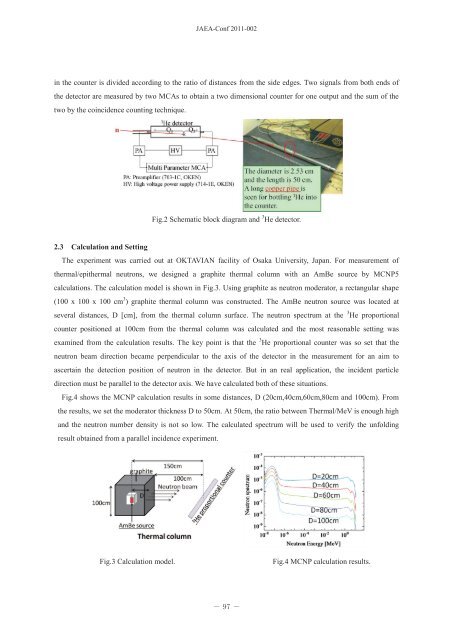JAEA-Conf 2011-002 - 日本原子力研究開発機構
JAEA-Conf 2011-002 - 日本原子力研究開発機構
JAEA-Conf 2011-002 - 日本原子力研究開発機構
Create successful ePaper yourself
Turn your PDF publications into a flip-book with our unique Google optimized e-Paper software.
<strong>JAEA</strong>-<strong>Conf</strong> <strong>2011</strong>-<strong>002</strong><br />
in the counter is divided according to the ratio of distances from the side edges. Two signals from both ends of<br />
the detector are measured by two MCAs to obtain a two dimensional counter for one output and the sum of the<br />
two by the coincidence counting technique.<br />
Fig.2 Schematic block diagram and 3 He detector.<br />
2.3 Calculation and Setting<br />
The experiment was carried out at OKTAVIAN facility of Osaka University, Japan. For measurement of<br />
thermal/epithermal neutrons, we designed a graphite thermal column with an AmBe source by MCNP5<br />
calculations. The calculation model is shown in Fig.3. Using graphite as neutron moderator, a rectangular shape<br />
(100 x 100 x 100 cm 3 ) graphite thermal column was constructed. The AmBe neutron source was located at<br />
several distances, D [cm], from the thermal column surface. The neutron spectrum at the 3 He proportional<br />
counter positioned at 100cm from the thermal column was calculated and the most reasonable setting was<br />
examined from the calculation results. The key point is that the 3 He proportional counter was so set that the<br />
neutron beam direction became perpendicular to the axis of the detector in the measurement for an aim to<br />
ascertain the detection position of neutron in the detector. But in an real application, the incident particle<br />
direction must be parallel to the detector axis. We have calculated both of these situations.<br />
Fig.4 shows the MCNP calculation results in some distances, D (20cm,40cm,60cm,80cm and 100cm). From<br />
the results, we set the moderator thickness D to 50cm. At 50cm, the ratio between Thermal/MeV is enough high<br />
and the neutron number density is not so low. The calculated spectrum will be used to verify the unfolding<br />
result obtained from a parallel incidence experiment.<br />
Fig.3 Calculation model. Fig.4 MCNP calculation results.

















